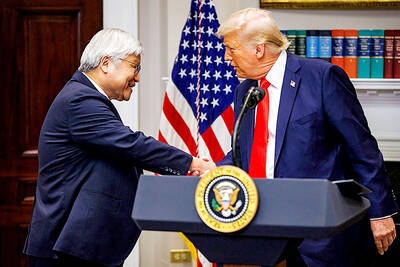The first agreement under the US-Taiwan Initiative on 21st Century Trade officially came into effect yesterday, marking a “significant milestone” in bilateral trade relations, the Office of Trade Negotiations said yesterday.
The agreement between Taiwan and the US covers commitments to customs administration and trade facilitation, regulatory practices, rules for running domestic service industries, anti-corruption, and small and medium-sized enterprises.
Both sides will continue to discuss implementation details and share any concerns, the office said in a statement.

Photo: I-Hwa Cheng, Bloomberg
This includes the establishment of committees on issues such as trade facilitation and good regulatory practices, as well as a liaison mechanism for small and medium-sized enterprises to ensure communication and coordination.
The Office of the US Trade Representative (USTR) also issued a statement on Monday confirming that the initial agreement had come into force.
“We thank our Taiwan partners for helping us reach this important milestone. The entry into force of the first agreement under our 21st Century Trade Initiative represents an important step forward in strengthening the US-Taiwan economic and trade relationship,” US Trade Representative Katherine Tai (戴琪) said in the statement.
The USTR previously submitted a certification to the US Congress stating that Taiwan had taken the measures necessary to comply with its obligations under the agreement, the statement said.
Both sides had notified each other that all procedures required for the agreement to enter into force had been completed, it said.
The US and Taiwan have been making progress on a second agreement under the US-Taiwan Initiative on 21st Century Trade, it said.
That agreement would address areas including labor, the environment and agriculture, and negotiations are ongoing, it said.
Taiwan’s trade office said the agreement had received unanimous support from Taiwan and the US Congress.
The two political parties in the US reviewed and approved it without objection in July, giving the agreement the status of an administrative agreement in the US Congress. That status made the legal basis for economic and trade exchanges between Taiwan and the US more solid, the trade office said.
To ensure that both nations can implement the agreement, the US Congress also approved the US-Taiwan Initiative on 21st Century Trade First Agreement Implementation Act in July last year following the passage of the first agreement, it said.
Taiwan and the US launched the Initiative on 21st Century Trade on June 1, 2022.
The first agreement under the initiative is an important “building block” toward a future free-trade agreement, the Office of Trade Negotiations said in May last year, calling it the “most comprehensive” deal agreed between the two trading partners since 1979.
Speaking to the media yesterday before attending a forum with business leaders, Premier Cho Jung-tai (卓榮泰) described it as a “significant day” for Taiwan-US relations.
He said it reflects both sides’ commitment to strengthening cooperation while deepening a broad range of ties.

CRITICAL MOVE: TSMC’s plan to invest another US$100 billion in US chipmaking would boost Taiwan’s competitive edge in the global market, the premier said The government would ensure that the most advanced chipmaking technology stays in Taiwan while assisting Taiwan Semiconductor Manufacturing Co (TSMC, 台積電) in investing overseas, the Presidential Office said yesterday. The statement follows a joint announcement by the world’s largest contract chipmaker and US President Donald Trump on Monday that TSMC would invest an additional US$100 billion over the next four years to expand its semiconductor manufacturing operations in the US, which would include construction of three new chip fabrication plants, two advanced packaging facilities, and a research and development center. The government knew about the deal in advance and would assist, Presidential

‘DANGEROUS GAME’: Legislative Yuan budget cuts have already become a point of discussion for Democrats and Republicans in Washington, Elbridge Colby said Taiwan’s fall to China “would be a disaster for American interests” and Taipei must raise defense spending to deter Beijing, US President Donald Trump’s pick to lead Pentagon policy, Elbridge Colby, said on Tuesday during his US Senate confirmation hearing. The nominee for US undersecretary of defense for policy told the Armed Services Committee that Washington needs to motivate Taiwan to avoid a conflict with China and that he is “profoundly disturbed” about its perceived reluctance to raise defense spending closer to 10 percent of GDP. Colby, a China hawk who also served in the Pentagon in Trump’s first team,

SEPARATE: The MAC rebutted Beijing’s claim that Taiwan is China’s province, asserting that UN Resolution 2758 neither mentions Taiwan nor grants the PRC authority over it The “status quo” of democratic Taiwan and autocratic China not belonging to each other has long been recognized by the international community, the Mainland Affairs Council (MAC) said yesterday in its rebuttal of Beijing’s claim that Taiwan can only be represented in the UN as “Taiwan, Province of China.” Chinese Minister of Foreign Affairs Wang Yi (王毅) yesterday at a news conference of the third session at the 14th National People’s Congress said that Taiwan can only be referred to as “Taiwan, Province of China” at the UN. Taiwan is an inseparable part of Chinese territory, which is not only history but

INVESTMENT WATCH: The US activity would not affect the firm’s investment in Taiwan, where 11 production lines would likely be completed this year, C.C. Wei said Investments by Taiwan Semiconductor Manufacturing Co (TSMC, 台積電) in the US should not be a cause for concern, but rather seen as the moment that the company and Taiwan stepped into the global spotlight, President William Lai (賴清德) told a news conference at the Presidential Office in Taipei yesterday alongside TSMC chairman and chief executive officer C.C. Wei (魏哲家). Wei and US President Donald Trump in Washington on Monday announced plans to invest US$100 billion in the US to build three advanced foundries, two packaging plants, and a research and development center, after Trump threatened to slap tariffs on chips made